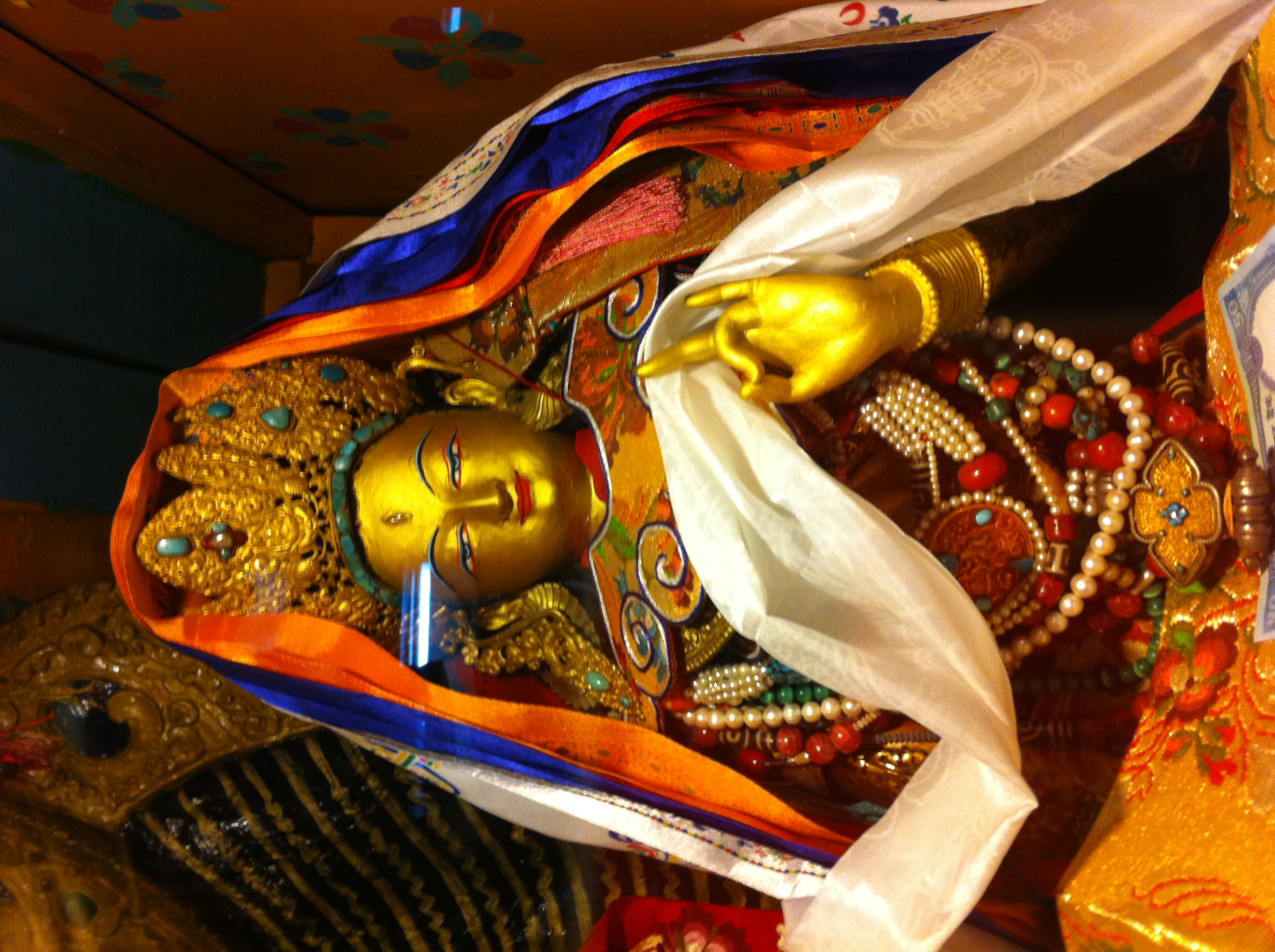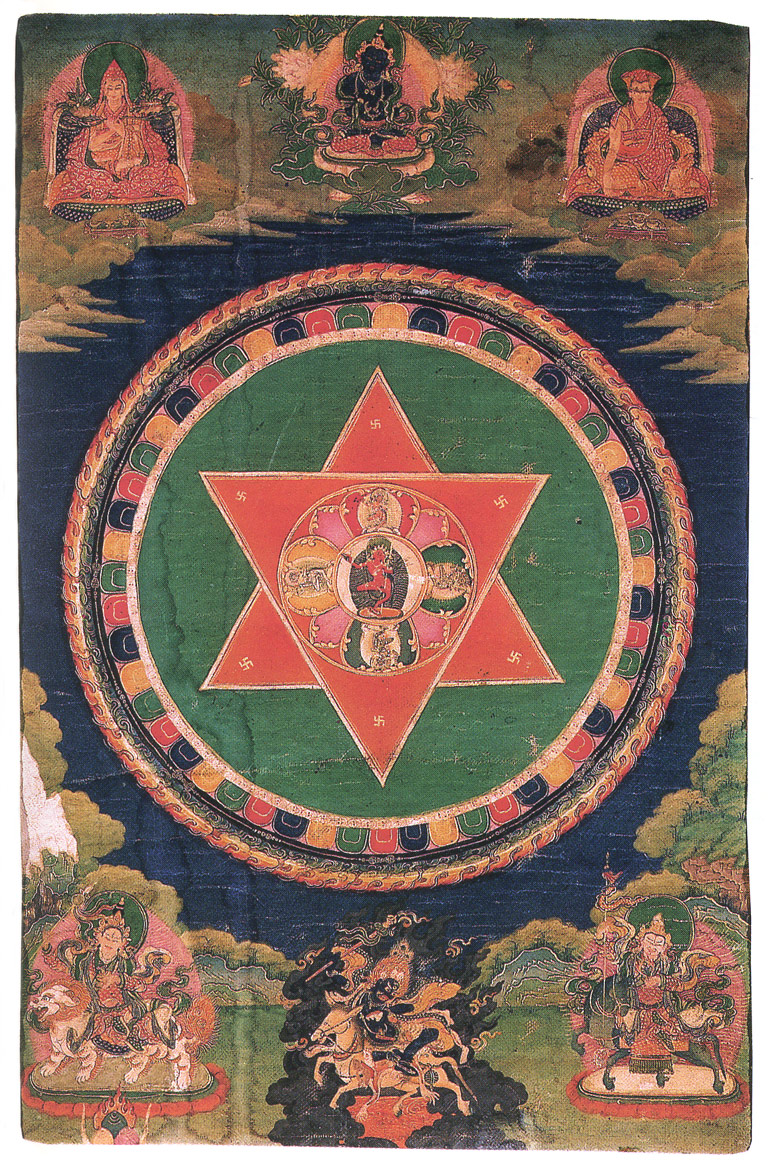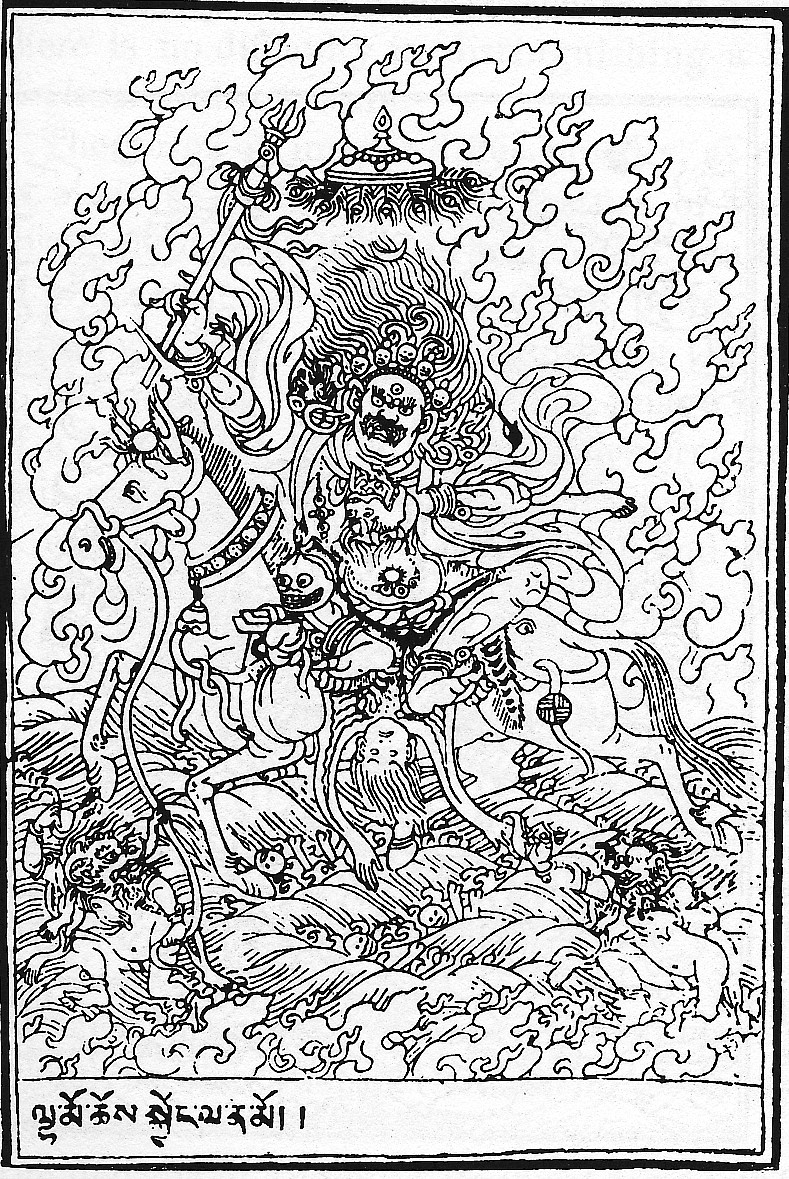|
Gendun Drub
Gedun Drupa (; 1391–1474) was considered posthumously to have been the 1st Dalai Lama. Biography Gedun Drupa was born in a cow-shed in Gyurmey Rupa near Sakya in the Tsang region of central Tibet, the son of Gonpo Dorjee and Jomo Namkha Kyi, nomadic tribespeople. He was raised as a shepherd until the age of seven. His birth name (according to the Tibetan Buddhist Resource Center, his personal name) was Péma Dorjee (, "Vajra Lotus"). Ordination Later he was placed in Narthang Monastery. In 1405, he took his śrāmaṇera (novitiate) vows from the abbot of Narthang, Khenchen Drupa Sherap. When he was 20 years old, in about 1411 received the name Gedun Drupa upon taking the vows of a bhikṣu (monk) from the abbot of Narthang Monastery.Thubten Samphel and Tendar (2004), p. 75. Also at this age he became a student of the scholar and reformer Je Tsongkhapa (1357–1419), who some say was his uncle.Thubten Samphel and Tendar (2004), p.35. Around this time he also became th ... [...More Info...] [...Related Items...] OR: [Wikipedia] [Google] [Baidu] |
Tibetan Buddhism
Tibetan Buddhism (also referred to as Indo-Tibetan Buddhism, Lamaism, Lamaistic Buddhism, Himalayan Buddhism, and Northern Buddhism) is the form of Buddhism practiced in Tibet and Bhutan, where it is the dominant religion. It is also in majority regions surrounding the Himalayan areas of India (such as Ladakh, Sikkim, Arunachal Pradesh, and a minority in Himachal Pradesh and Uttarakhand), in much of Central Asia, in the southern Siberian regions such as Tuva, and in Mongolia. Tibetan Buddhism evolved as a form of Mahāyāna Buddhism stemming from the latest stages of Indian Buddhism (which also included many Vajrayāna elements). It thus preserves many Indian Buddhist tantric practices of the post-Gupta early medieval period (500 to 1200 CE), along with numerous native Tibetan developments. In the pre-modern era, Tibetan Buddhism spread outside of Tibet primarily due to the influence of the Mongol Yuan dynasty (1271–1368), founded by Kublai Khan, which had ruled China, ... [...More Info...] [...Related Items...] OR: [Wikipedia] [Google] [Baidu] |
5th Dalai Lama
Ngawang Lobsang Gyatso (; ; 1617–1682) was the 5th Dalai Lama and the first Dalai Lama to wield effective temporal and spiritual power over all Tibet. He is often referred to simply as the Great Fifth, being a key religious and temporal leader of Tibetan Buddhism and Tibet. Gyatso is credited with unifying all Tibet under the Ganden Phodrang after a Mongol military intervention which ended a protracted era of civil wars. As an independent head of state, he established relations with the Qing empire and other regional countries and also met early European explorers. Gyatso also wrote 24 volumes' worth of scholarly and religious works on a wide range of subjects. Early life To understand the context within which the Dalai Lama institution came to hold temporal power in Tibet during the lifetime of the 5th, it may be helpful to review not just the early life of Lobsang Gyatso but also the world into which he was born, as Künga Migyur. Künga Migyur's family The child who would ... [...More Info...] [...Related Items...] OR: [Wikipedia] [Google] [Baidu] |
Dalai Lamas
Dalai Lama (, ; ) is a title given by the Tibetan people to the foremost spiritual leader of the Gelug or "Yellow Hat" school of Tibetan Buddhism, the newest and most dominant of the four major schools of Tibetan Buddhism. The 14th and current Dalai Lama is Tenzin Gyatso, who lives as a refugee in India. The Dalai Lama is also considered to be the successor in a line of tulkus who are believed to be incarnations of Avalokiteśvara, the Bodhisattva of Compassion. Since the time of the 5th Dalai Lama in the 17th century, his personage has always been a symbol of unification of the state of Tibet, where he has represented Buddhist values and traditions. The Dalai Lama was an important figure of the Geluk tradition, which was politically and numerically dominant in Central Tibet, but his religious authority went beyond sectarian boundaries. While he had no formal or institutional role in any of the religious traditions, which were headed by their own high lamas, he was a unifying symb ... [...More Info...] [...Related Items...] OR: [Wikipedia] [Google] [Baidu] |
1474 Deaths
Year 1474 ( MCDLXXIV) was a common year starting on Saturday (link will display the full calendar) of the Julian calendar. Events January–December * February – The Treaty of Utrecht puts an end to the Anglo-Hanseatic War. * March 19 – The Senate of the Republic of Venice enacts the ''Venetian Patent Statute'', one of the earliest patent systems in the world. New and inventive devices, once put into practice, have to be communicated to the Republic to obtain the right to prevent others from using them. This is considered the first modern patent system. * July 25 – By signing the Treaty of London, Charles the Bold of Burgundy agrees to support Edward IV of England's planned invasion of France. * December 12 – Upon the death of Henry IV of Castile, a civil war ensues between his designated successor Isabella I of Castile, and her niece Juana, who is supported by her husband, Afonso V of Portugal. Isabella wins the civil war after a lengthy struggl ... [...More Info...] [...Related Items...] OR: [Wikipedia] [Google] [Baidu] |
1391 Births
Year 1391 ( MCCCXCI) was a common year starting on Sunday (link will display full calendar) of the Julian calendar. Events January–December * June 6 – Massacre of 1391: Anti-Jewish pogroms erupt in Seville, Spain. Many thousands of Jews are massacred, and the violence spreads throughout Spain and Portugal, especially to Toledo, Barcelona and Mallorca. This event marks a turning-point in the history of the Spanish Jews, with most of the survivors leaving the Iberian Peninsula or being forced to convert. * July 18 – Tokhtamysh–Timur war: Battle of the Kondurcha River – Timur defeats Tokhtamysh of the Golden Horde, in present day southeast Russia. Date unknown * Manuel II Palaiologos becomes Byzantine emperor after his father, John V Palaiologos, dies of a nervous breakdown, due to his continued humiliation by the Ottoman Empire. * Yusuf II succeeds Muhammed V, as Nasrid Sultan of Granada (now southern Spain). * Stephen Dabiša succeeds Stephe ... [...More Info...] [...Related Items...] OR: [Wikipedia] [Google] [Baidu] |
Tara (Buddhism)
Tara ( sa, तारा, ; bo, སྒྲོལ་མ, ), Ārya Tārā, or Shayama Tara, also known as Jetsun Dölma (Tibetan: ''rje btsun sgrol ma'') is an important figure in Buddhism, especially revered in Tibetan Buddhism. She appears as a female bodhisattva in Mahayana Buddhism, and as a female Buddha in Vajrayana Buddhism. She is known as the "mother of liberation", and represents the virtues of success in work and achievements. She is known as ''Duōluó Púsà'' (多羅菩薩) in Chinese Buddhism, and as ''Tara Bosatsu'' (多羅菩薩) in Japan. Tārā is a meditation deity revered by practitioners of the Tibetan branch of Vajrayana Buddhism to develop certain inner qualities and to understand outer, inner and secret teachings such as karuṇā (compassion), mettā (loving-kindness), and shunyata (emptiness). Tārā may more properly be understood as different aspects of the same quality, as bodhisattvas are often considered personifications of Buddhist methods. Ther ... [...More Info...] [...Related Items...] OR: [Wikipedia] [Google] [Baidu] |
Gautama Buddha
Siddhartha Gautama, most commonly referred to as the Buddha, was a wandering ascetic and religious teacher who lived in South Asia during the 6th or 5th century BCE and founded Buddhism. According to Buddhist tradition, he was born in Lumbini, in what is now Nepal, to royal parents of the Shakya clan, but renounced his home life to live as a wandering ascetic ( sa, śramaṇa). After leading a life of begging, asceticism, and meditation, he attained enlightenment at Bodh Gaya in what is now India. The Buddha thereafter wandered through the lower Indo-Gangetic Plain, teaching and building a monastic order. He taught a Middle Way between sensual indulgence and severe asceticism, leading to Nirvana, that is, freedom from ignorance, craving, rebirth, and suffering. His teachings are summarized in the Noble Eightfold Path, a training of the mind that includes meditation and instruction in Buddhist ethics such as right effort, mindfulness, and '' jhana''. He di ... [...More Info...] [...Related Items...] OR: [Wikipedia] [Google] [Baidu] |
Empowerment (Vajrayana)
In Vajrayāna Buddhism, esoteric transmission is the transmission of certain teachings directly from teacher to student during an empowerment (''abhiṣeka'') in a ritual space containing the mandala of the deity. Many techniques are also commonly said to be secret, but some Vajrayana teachers have responded that secrecy itself is not important and only a side-effect of the reality that the techniques have no validity outside the teacher-student lineage. The secrecy of teachings was often protected through the use of allusive, indirect, symbolic and metaphorical language (twilight language) which required interpretation and guidance from a teacher. The teachings may also be considered "self-secret", meaning that even if they were to be told directly to a person, that person would not necessarily understand the teachings without proper context. In this way, the teachings are "secret" to the minds of those who are not following the path with more than a simple sense of curiosity. B ... [...More Info...] [...Related Items...] OR: [Wikipedia] [Google] [Baidu] |
Bodongpa
The Bodongpa or Bodong tradition, is one of the smaller traditions of Tibetan Buddhism falling outside the classification of the four main schools. History Bodong E Monastery (), located in Yutok (), in modern Tashigang (), Lhatse County, was the main monastery of the Bodong tradition. It was first established in 1049 by the Kadam (Tibetan Buddhism) teacher Mudra Chenpo (). Bodong tradition itself goes back to Bodong Rinchen Tsemo, who received teachings from Drubthob Semo Chewa. Its most renowned figure, often regarded as its founder, was the Bodong Penchen Lénam Gyelchok (, 1376-1451), whose seat was at this monastery. Bodong Penchen authored over one hundred and thirty-five volumes and is known as the most prolific writer in Tibetan history. His most famous work is the ''Compendium of Suchness'' () comprising one hundred and thirty-three volumes having about 500 folios (1000 pages) in each. The extensive version contains one hundred and ten volumes; the medium version, tw ... [...More Info...] [...Related Items...] OR: [Wikipedia] [Google] [Baidu] |
Samding Dorje Phagmo
The Samding Dorje Phagmo () is the highest female incarnation in Tibet''The Power-places of Central Tibet: The Pilgrim's Guide'', (1988) p. 268. Keith Dowman. . and the third highest-ranking person in the hierarchy after the Dalai Lama and the Panchen Lama. She was listed among the highest-ranking reincarnations at the time of the 5th Dalai Lama, recognized by the Tibetan government and acknowledged by the emperors of Qing China. In her first incarnation, as Chökyi Drönma (1422 CE–1455 CE), she was the student and consort of the famous polymath Thang Tong Gyalpo, who first identified her as an emanation of Vajravārāhī, and the consort of Bodong Panchen. The seat of the Samding Dorje Phagmo is at Samding Monastery, in Tibet. History and background The seat of the Samding Dorje Phagmo is at the Samding Monastery "Temple of Soaring Meditation." The Samding Monastery is associated with the Bodong school of Tibetan Buddhism. It was unique because half of the inhabitants were ... [...More Info...] [...Related Items...] OR: [Wikipedia] [Google] [Baidu] |
Lhamo La-tso
Lhamo Latso or Lha-mo La-tso () is a small oval oracle lake where senior Tibetan monks of the Gelug sect go for visions to assist in the discovery of reincarnations of the Dalai Lamas. Other pilgrims also come to seek visions. It is considered to be the most sacred lake in Tibet."Lhamo Latso Lake" It is also known as "The Spiritual-Lake of the Goddess", the goddess being , the principal Protectress of Tibet. Other names include: Tso Lhamo (mTsho Lha mo), Chokhorgyelgi Namtso (Chos 'khor rgyal gyi gnam mtsho) and Makzorma (dmag zor ma) and, on old maps, as Cholamo. Palden Lhamo and Lhamo Latso [...More Info...] [...Related Items...] OR: [Wikipedia] [Google] [Baidu] |

.jpeg/1200px-Tibetan_Buddhism_(214837929).jpeg)


.jpg)
.jpg)

